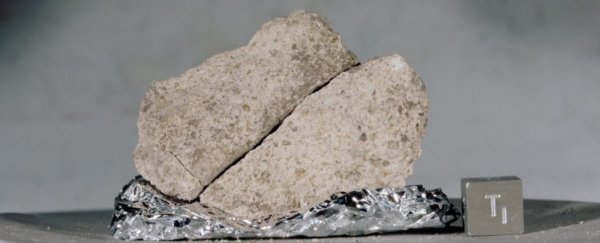A nanoscopic speck of Moon dust, roughly as wide as a human hair, can now be analysed in high resolution atom by atom.
Using an innovative approach called atom probe tomography (APT), researchers at the University of Chicago say they have found a way to conserve our limited sample of precious Moon rocks, gathered during the Apollo missions.
"Fifty years ago, no one anticipated that someone would ever analyse a sample with this technique, and only using a tiny bit of one grain," says geophysicist Philipp Heck from the University of Chicago, who is also a curator at the Field Museum.
"Thousands of such grains could be on the glove of an astronaut, and it would be sufficient material for a big study."
It's mind-boggling to think that something so small can contain so much information, let alone that we can somehow access that library of knowledge.
APT, the ingenious technique that gives us this access, is so sensitive, it can image a tiny sample of material atom-by-atom, giving researchers a powerful 3D analysis of the source.
To analyse a grain of Moon dust with APT, geophysicist Jennika Greer at the University of Chicago prepared a needle-shaped sample just a few hundred atoms wide - she carved this teeny tiny pillar out of the grain with a focused beam of charged atoms.
"We can use the expression nanocarpentry," explains Heck. "Like a carpenter shapes wood, we do it at the nanoscale to minerals."
 Preparing 'needles' to be lifted off the dust grain. (Greer et al., Meteoritics & Planetary Science, 2020)
Preparing 'needles' to be lifted off the dust grain. (Greer et al., Meteoritics & Planetary Science, 2020)
Then came the atom probe part - using a laser, the researchers knocked atoms off their needle-shaped sample one by one, watching each atom fly off and strike a detector plate.
Certain elements will fly off the sample at different rates, and this allowed researchers to analyse the sample's true composition and texture. For instance, it takes iron longer to reach the detector plate compared to hydrogen, because it's a heavier element.
 A tiny, sharpened piece of a grain of Moon dust. (Jennika Greer/Field Museum)
A tiny, sharpened piece of a grain of Moon dust. (Jennika Greer/Field Museum)
The authors say this is the first time we have been able to see both the types of atoms and their exact locations in a tiny grain of lunar soil. Even better, because they took so little material off the grain, the original sample is still largely intact and available for future research.
"This technique has such high sensitivity and resolution, you find things you wouldn't find otherwise and only use up a small bit of the sample," says Heck.
The results have already convinced NASA to fund three years of study on lunar dust, using APT to quantify the water content and level of space weathering.
Recently, researchers have suggested the Moon holds large reserves of water in the deeper subsoil layer; and being able to find evidence of this in the soil samples we already have would be huge.
Unlike our own planet, the Moon doesn't have an atmosphere to protect it. And space is a harsh environment, especially with the Sun beating down on it, sending endless streams of solar particles and cosmic rays of radiation.
The Moon's soil has been so deeply altered by this weathering, what lies inside the satellite likely doesn't match its exterior. By understanding how the surface has changed, the authors of the new study hope we can somehow reverse the clock and try and figure out what lunar soil once used to be.
In the nanoscale 3D map Greer and colleagues created of their Moon dust sample, the team notes several products of space weathering, including microphase iron, hydrogen and even a vesicle that may have once been filled with ions from solar wind.
"Because of something like this, we understand what the environment is like on the Moon," Greer says.
"It goes way beyond what astronauts are able to tell us as they walk on the Moon. This little grain preserves millions of years of history."
The study was published in Meteoritics & Planetary Science.
